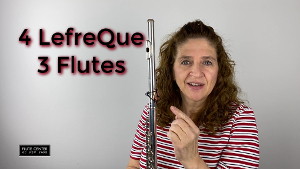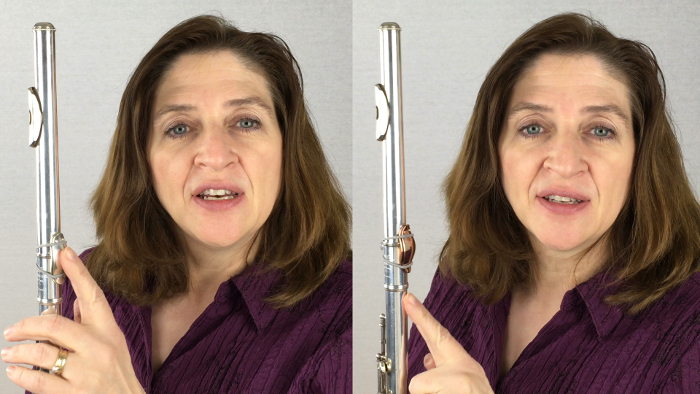To LefreQue or Not to LefreQue. That is the Question.
Pronounced “le freak” by founder Hans Kuijt, LefreQue sound bridges claim to enhance the sound characteristics of wind instruments as follows:
- Purer overtones
- Better tuning
- Easier playing
- Better slurring
- Surround projection
- Extended dynamics
So, what do you think? Have you tried them?
A lot of people seem to have one of these sound bridges. So, popular opinion seems to approve. However, I’ve heard these benefits described as the placebo effect. That is, you believe that you WILL sound better using the LefreQue so, when you use them, you THINK you did sound better.

So, should you spend the money for a LefreQue? It isn’t chump change to buy one of these engineering marvels. On the other hand, buying the gold LefreQue would be much cheaper than buying a new headjoint. If you’re looking for a new sound, you may want to consider a LefreQue sound bridge.
In my experimentation with the LefreQue, I found that the sound is different. But my question (still undecided) is: is the sound better, or is it just a preference? I made a video of me trying the LefreQue for the very first time on my flute (Haynes solid silver, 14-karat gold riser). I played with a rose gold LefreQue, a silver LefreQue, and no LefreQue. I told you what I heard. Then I ended with a blind test to see if you could tell the difference. Take a listen and let me know what you think. (The blind test begins at 11 minutes.) The consensus so far is that there is a clear difference between the 3 examples. But the question remains – is it better or just different.
The more I played with the bridges the more differences I heard. I do think that one needs to play around with them to use them to best advantage. The articulated response time was an area where I do think there was the biggest difference. I felt that the tongue/sound response was quick and clear.
If that is the case, I’m all in!
I also wonder if the sound itself is packaged with more clarity. If that is the case, I’m all in! What often happens, with me anyway, is when I play a new flute or headjoint, I think that it sounds really phenomenal. But then when I go back to my flute: viola! the great sound is there as well. This makes me come down on the side of the placebo effect. I do think that recording yourself is very helpful. It gives you a more unbiased view of the situation. You can hear the tone as someone else would hear it, not as it echoes through your sinuses and to your ears. This gives you such a new perspective. I also find it helpful to ask opinions of other flutists when I try new instruments (or sound bridges). It helps to listen to others opinions about what they heard. Of course in today’s world, if you don’t have anyone to listen you, you do have a recording device at your fingertips.
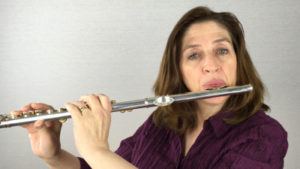 When you try the LefreQue one of the most important aspects to get the correct sound is to put it on correctly. The design engineer suggests that the bridge needs to be attached from headjoint to body where there are no keys. I have seen many a video of a flutist with the bridge attached incorrectly. (To help with this process I wrote a blog and made 2 videos about how to attach the LefreQue to your flute properly.) I think that the promises of the designer are not fully in effect when the bridge is incorrectly applied.
When you try the LefreQue one of the most important aspects to get the correct sound is to put it on correctly. The design engineer suggests that the bridge needs to be attached from headjoint to body where there are no keys. I have seen many a video of a flutist with the bridge attached incorrectly. (To help with this process I wrote a blog and made 2 videos about how to attach the LefreQue to your flute properly.) I think that the promises of the designer are not fully in effect when the bridge is incorrectly applied.
A possible drawback to adding a LefreQue to your flute is the added weight. Obviously, for many people this is not an issue. But for some, the weight could add to an already existing hand problem. If you are one of these people, the added weight is enough to give you pause. So, I would try to get a trial period where you could find out whether or not this was a good addition to your flute.
What Do You Hear?
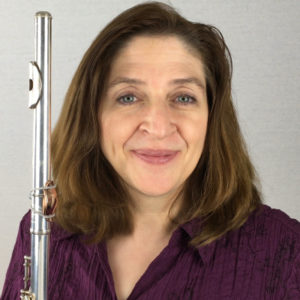 When I played my flute with the added sound bridge, I thought that the tone got moving faster or the vibrations occurred quicker. This made me feel that my tone was a bit bigger and that it spoke easier. The gold LefreQue made my low register tone color quite different. It also gave me an edgier sound. I can think of a number of solos that could use this extra edge.
When I played my flute with the added sound bridge, I thought that the tone got moving faster or the vibrations occurred quicker. This made me feel that my tone was a bit bigger and that it spoke easier. The gold LefreQue made my low register tone color quite different. It also gave me an edgier sound. I can think of a number of solos that could use this extra edge.
In the end I do think that the LefreQue made a difference to my sound and for the savings of buying a new headjoint, it might be worth the investment.
Take a listen to the video and see what you think about these bridges. I think the LefreQue sound bridge is something to explore. Since every flute is different, it’s worth trying these to see what they can do for you. They may give you the new sound that you’re looking for.
I didn’t have time to explore the intonation, dynamics and tone color claims. It would be interesting to play with these in front of a tuner.
Try these on your own and see what they do for you. Hey it is cheaper the a new flute!
Have fun!
Doctor Flute
Watch me demonstrate this: To LefreQue or Not to LefreQue. That is the Question. Can You Hear the Difference?
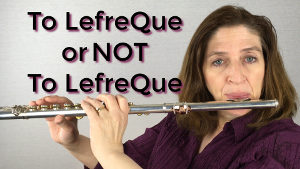
How To Attach a LefreQue to Your Flute
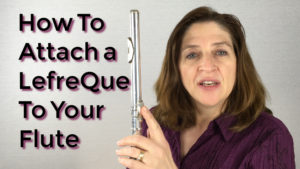
How To Attach a LefreQue to Your Flute Closeup
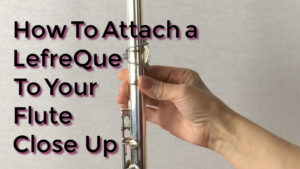
LefreQue for Flute Testing 4 LefreQue on 3 Flute Levels – FCNY Sponsored
